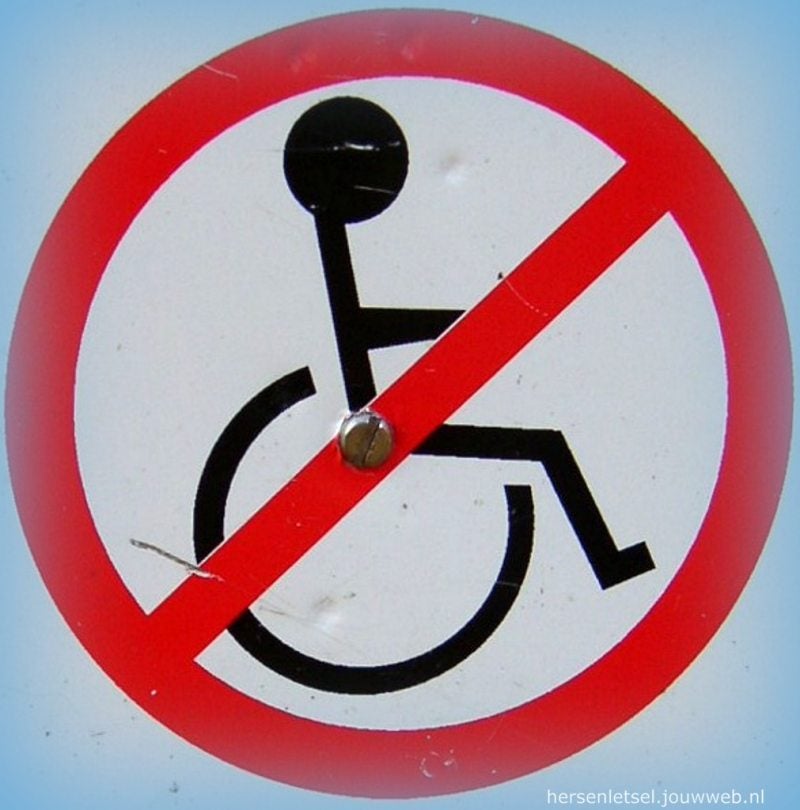Invisible consequences
See text below this submenu

When you are not in a wheelchair... Non-visible consequences are often being overlooked. Many people do have brain injury, but have no physical handicaps.
Usually the physical limitations that brain injury survivors do have, are recognized by caregivers and loved ones. But the invisible and / or cognitive effects are sometimes noticed later. Complaints are often first recognized when patients begin participating in society. At that time, it may appear that the patient no longer succeeds in doing certain things.
Memory problems, fatigue, anxiety, irritability. These are some examples of cognitive complaints in patients with brain injury may experience. These consequences may manifest themselves months or years after the brain injury. What are other possible consequences?
Invisible consequences at a glance:
One person may have one or two of these symptoms, the other has several.
- Fatigue (Tired, very tired)
- Memory problems
- Concentration problems, slower speed of thinking and information processing
- Divided attention does not work or work under pressure
- Sensory problems ... Read more about the visual effects in brain
- Agnosia, not recognizing (objects, texts, colors, etc.)
- Prosopagnosia, not recognizing faces
- Apraxia, difficulty performing everyday movements and sequence of operations
- Aphasia, difficulty speaking or understanding speech act or read (sub Aphasia)
- Language difficulties - or not letting another to speak
- Understanding language literally
- Speach-apraxia, speaking haltingly, lesser articulation
- Other communication difficulties
- Orientation issues
- Decreased sense of time
- Difficulty with problem solving
- Decreased rate of reaction
- Slower learning new things
- Decreased ability to assess situations (also overestimates himself sometimes, also in terms of what those whose health may adjust)
- Reduced ability to plan, organize and / or carry out
- Diminished ability to think flexibly
- Reduced or no overview (hence difficulty in directing household eg., or how to prepare a meal, or to see a problem in its entirety, or problems with buying. Or difficulties to grasp / can not answer to an open question like: "What help do you need? "or" How are you? "" Can I do something for you? ")
- Neglect, (not perceiving or less-) of a body part or one side of the room
- Sexual problems
- Persevering; can not stop an act
- Difficulty generalizing; can not apply what they have learned in other situations
- Enhanced perception of sound, smell, sight and light, taste, touch
- Hypersensitivity to external stimuli: hypersensitive to sound, light sensitivity)
- Headache
- Problems with strength and coordination of limbs
- Temperature regulation disorder, can not cool down in hot weather or heat and can not warm up in cold weather or cold
- Changes in personality / behavioral changes (whether or disinhibited behavior, easily angered, or faster emotional, enthusiastic, very busy or reluctant, irritable or rebellious)
- Aggression
- Anosognosia (no awareness of illness) or reduced disease understanding
- Disharmonious profile: eg: Someone can be verbally strong and on the other hand perform very poorly on executive functions; he/she can not plan or overlook situations.
(The cognition is measured by an intelligence test. These samples a total IQ (TIQ). This is divided between a verbal part (VIQ), focusing on verbal knowledge and skills, and a performal part (PIQ), focused on action-oriented thinking. There may be great differences between the VIQ and PIQ. This is called a disharmonious intelligence profile. Note that a disharmonious profile is not alway caused by brain injury. It occurs in highly gifted individuals. Read more about VIQ - PIQ discrepency in this article.)
Read more about cognitive problems after brain injury.
-
Often someone with a brain injury has no visible physical signs of injury, and by this may have trouble convincing others that they do have a disability.
"My insurance company says I am better and don't need any more rehabilitation".
"Mum and dad say it's all in my head, that I'm making all this up".
"The boss thinks I look fine and should be able to handle the huge workloads again".